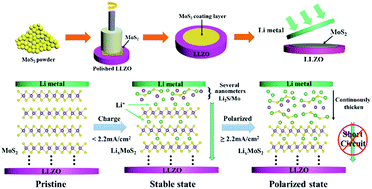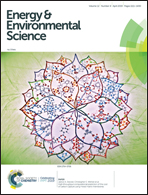In situ formation of a bifunctional interlayer enabled by a conversion reaction to initiatively prevent lithium dendrites in a garnet solid electrolyte†
Abstract
Adopting inorganic solid electrolytes (ISEs) is a promising approach to assemble batteries using Li metal anodes because of their superior Li-ion conductivity and high mechanical strength. This approach greatly improves the energy density and the safety of batteries. However, lithium dendrites still can pierce the bare ISE because of inhomogeneous current distributions at interfaces, leading to serious short circuits. This work proposes to reduce the interfacial resistance and prevent lithium dendrite growth simultaneously through in situ formation of interlayers enabled by a conversion reaction of MoS2 layers coated on a bare Li6.5La3Zr1.5Ta0.5O12 (LLZO) pellet. The interfacial resistance is reduced to only 14 Ω cm2, with the overpotential decreasing notably. The critical current density of cells is improved from 0.7 mA cm−2 to 2.2 mA cm−2. Furthermore, short circuits are significantly suppressed above the critical current density with the potential diverging quickly. The cell can be recovered to some extent by applying an inverse potential for a short time. The comparison between XPS and XAS measurements reveals that the nanoscale thin MoS2 layer in contact with the Li anode can be converted into an interlayer composed of Mo and Li2S through the conversion reaction. The sluggish kinetics of the conversion reaction resulting from the poor electronic conductivity makes the in situ-formed interlayer kinetically stable, which can hinder further reaction of MoS2 with Li effectively. Moreover, the in situ reaction could suppress the local tip electric field effect efficiently and make the current distribution more even. This study provides a new strategy to optimize the interface of anodes by screening for more candidates which undergo a conversion reaction.



 Please wait while we load your content...
Please wait while we load your content...